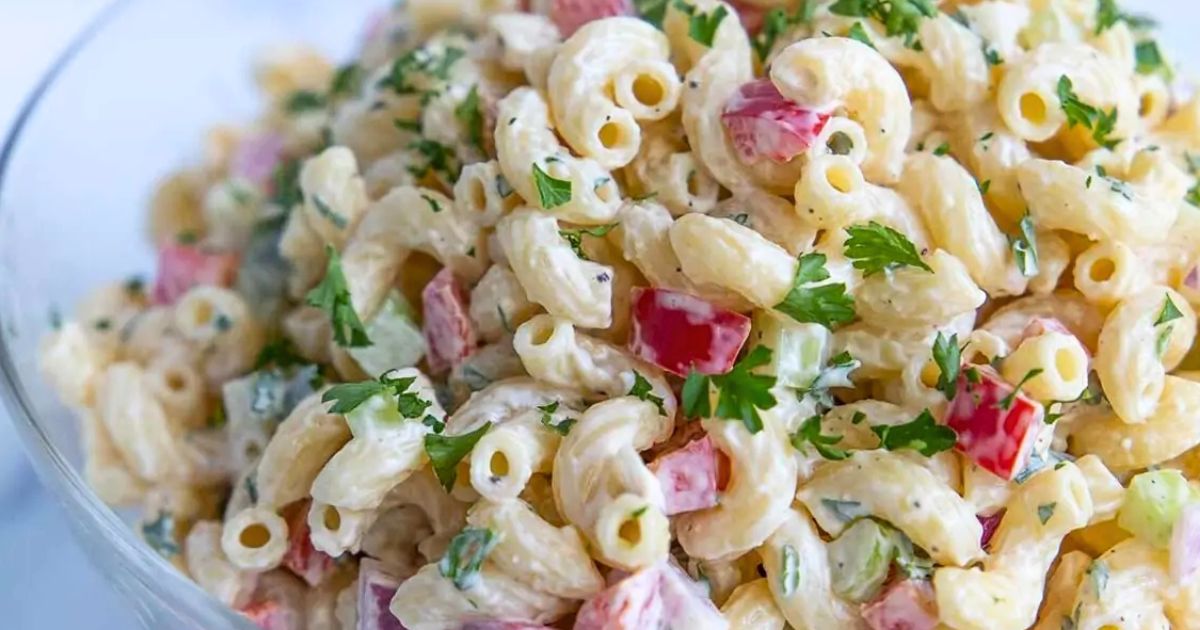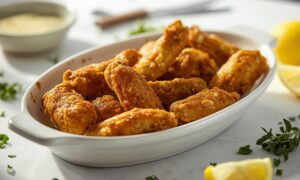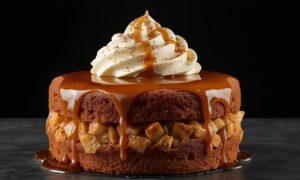Macaroni Salad Recipe – Classic, Creamy, and Easy to Make! The first time I encountered a truly transcendent macaroni salad, I wasn’t at some fancy deli counter or upscale restaurant. I was at my grandmother’s kitchen table on a sweltering July afternoon in Alabama.
Her hands moved with practiced precision as she folded mayonnaise into perfectly cooked elbow pasta. She added just the right amounts of crunchy celery, sharp onion, and her “secret ingredient” a splash of pickle juice. This cut through the richness with bright acidity. This wasn’t just pasta with mayo; it was edible heritage.
Macaroni salad occupies a peculiar place in American culinary tradition. It is often dismissed as mere picnic fare or a deli counter afterthought. However, a properly executed macaroni salad can actually be a sophisticated study in texture, balance, and nostalgia. Its deceptive simplicity hides remarkable depth, making it one of the most misunderstood classics in our collective food memory.
Ingredients & Substitutions
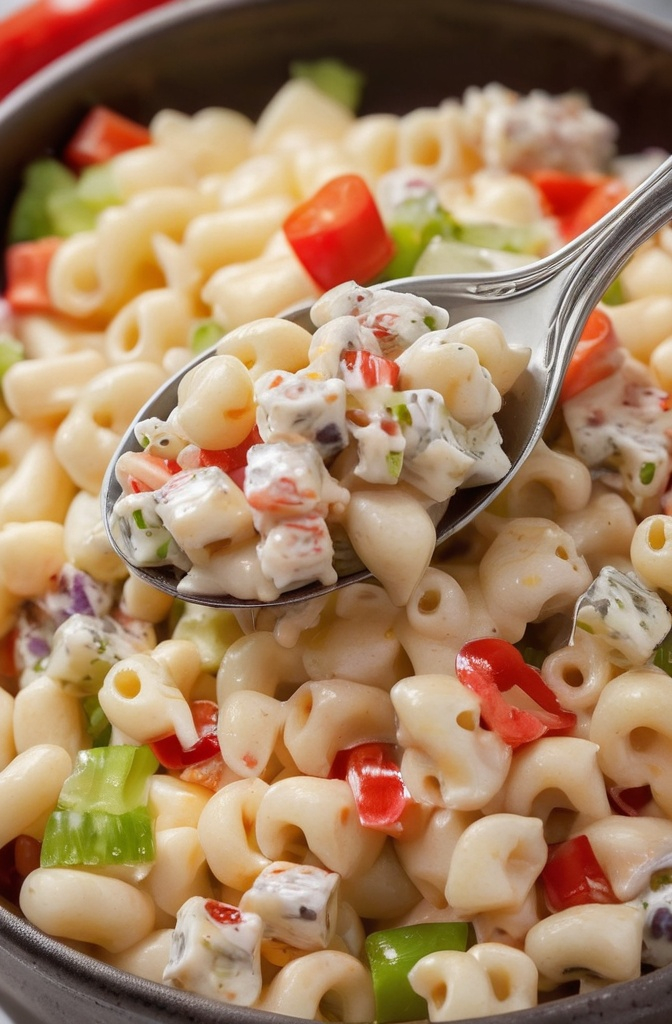
The Foundation: Pasta
At its core, macaroni salad begins with, you guessed it, macaroni. But don’t think your choices end with standard elbow pasta. Different pasta shapes absorb dressing differently and create unique textural experiences. Classic elbow macaroni offers the perfect little pockets for dressing to hide in, while small shells trap little bursts of flavor. Ditalini creates a more uniform texture, and farfalle (bow ties) offers visual interest with a slightly firmer bite.
Regardless of shape, proper cooking is everything. For macaroni salad, you want pasta cooked just beyond al dente, what I call “picnic perfect.” It should be soft enough to easily fold with other ingredients, yet firm enough to maintain structural integrity after chilling. Always cook your pasta in heavily salted water it should taste “like the sea” as Italian grandmothers say. And for heaven’s sake, rinse your pasta under cold water immediately after cooking! This stops the cooking process and removes excess starch that would otherwise make your salad gummy.
For those with gluten sensitivities, modern rice, corn, or chickpea pastas can work wonderfully. Just be aware they may require slightly different cooking times, and the texture won’t be identical. I’ve had particularly good results with corn-rice blends, which hold their shape nicely even when cold.
The Binding Agent: Dressing
The quintessential macaroni salad dressing features mayonnaise as its primary component. Full-fat, real mayonnaise not the sweet sandwich spread some mistake for mayo creates the optimal creamy base. Duke’s is my prefered brand for its tanginess and lack of added sugar, but Hellmann’s/Best Foods runs a close second. Whatever you choose, avoid “light” versions; they contain more water and will leave your salad watery after sitting.
Many home cooks stop at mayo, but the best macaroni salads incorporate a more complex dressing. A tablespoon or two of Dijon mustard adds depth, while a splash of apple cider vinegar or that aformentioned pickle juice introduces necessary acidity. A teaspoon of honey can round out the sharpness, creating perfect balance. For tangier versions, folding in a dollop of sour cream or Greek yogurt introduces pleasant complexity.
For dairy-free or vegan versions, several excellent plant-based mayonnaises now exist. I’m particularly impressed with those made from avocado oil, which offer richness without odd aftertastes. Alternatively, a dressing based on olive oil, vinegar, and a touch of mustard creates a Mediterranean-inspired variation that’s lighter yet still cohesive.
The Supporting Cast: Mix-ins
The magic of a great macaroni salad lies in the carefully chosen mix-ins that provide contrast in texture, color, and flavor. Traditional versions incorporate finely diced celery for crunch, red or green onion for sharpness, and often bell peppers for sweetness and color. These vegetables should be diced small enough to distribute throughout the salad but large enough to maintain textural identity.
Hard-boiled eggs create richness and protein, while diced pickles (sweet or dill, depending on preference) contribute both crunch and acidity. Proteins like diced ham, crumbled bacon, or flaked tuna transform a side dish into a complete meal. More contemporary versions might incorporate olives, sundried tomatoes, or even crumbled feta for Mediterranean notes.
Fresh herbs deserve special mention. A handful of chopped parsley adds color and freshness, while dill creates distinctive flavor that pairs beautifully with creamy dressings. For unexpected complexity, try a bit of fresh tarragon or basil.
Seasoning is where most mediocre macaroni salads fail. Besides salt and pepper, consider adding celery seed (a classic that adds distinctive flavor), paprika (both for color and mild sweetness), or a pinch of cayenne for subtle heat. My persnl favorite addition is a dash of Old Bay seasoning, which introduces complex notes that guests can’t quite identify but find irresistable.
Step-by-Step Instructions for Macaroni Salad Marvel
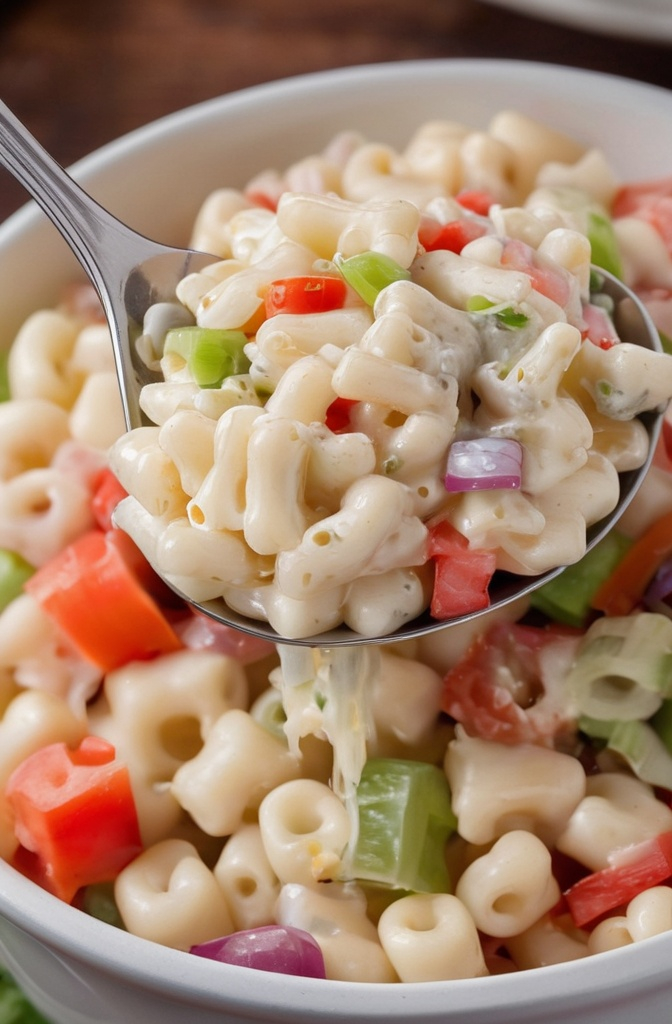
The Perfect Macaroni Salad Method
Begin by filling a large pot with water more water than you think necessary. Crowding pasta leads to uneven cooking and sticking. Add a generous amount of salt (about 1 tablespoon per 4 quarts of water), and bring to a rolling boil.
Add 1 pound of your chosen pasta and stir immediately to prevent sticking. Set a timer for 1 minute less than the package directions suggest, then begin tasting. For macaroni salad, you want the pasta just past al dente tender but not mushy. Remember that the pasta will firm slightly when chilled.
Once cooked, drain thoroughly in a colander, then rinse under cold running water, tossing constantly until the pasta is completely cooled. This critical step removes surface starch and halts cooking. After rinsing, shake the colander vigorously to remove excess water too much moisture will dilute your dressing.
Transfer the cooled pasta to your largest mixing bowl, which allows ample space for folding ingredients without spillage. Drizzle with a tablespoon of olive oil and toss gently. This preventative measure keeps the pasta from clumping while you prepare other ingredients.
While the pasta cools completely, prepare your mix-ins. Uniformity of size is key aim for pieces about a quarter-inch dice for most vegetables. For onions, which deliver stronger flavor, an even finer dice prevents overwhelming bites. Hard-boiled eggs should be cooled completely before incorporating to prevent the whites from turning rubbery.
In a separate bowl, combine your dressing ingredients, whisking until smooth. Always taste your dressing before adding to pasta, remembering that cold temperatures mute flavors. The dressing should taste slightly more seasoned than seems necessary at room temperature.
When combining components, use a large rubber spatula or wooden spoon with a folding motion rather than aggressive stirring. This preserves the integrity of delicate ingredients and prevents pasta breakage. Add about two-thirds of your dressing initially, fold thoroughly, then assess consistency. Add remaining dressing as needed different pastas absorb dressing at different rates.
Cover the finished salad and refrigerate for at least two hours before serving, though overnight is ideal. The resting period allows flavors to meld and the pasta to absorb seasonings. Before serving, taste again and adjust seasonings, as cold temperatures dampen flavor perception. Often a final squeeze of lemon juice or splash of vinegar brightens the entire dish.
Common Mistakes and Solutions
The most frequent error in macaroni salad preparation is underdressing initially, then adding more dressing just before serving. This creates a slick coating rather than allowing the pasta to absorb flavors. Instead, dress adequately at the beginning, then refresh with a small amount of reserved dressing if needed.
Another pitfall is oversalting the pasta water, then adding salty mix-ins like pickles or olives, resulting in an inedibly saline final product. If your salad tastes too salty, adding a bit more undressed pasta or a diced potato (which absorbs salt) can help salvage it.
Texture problems usually stem from overcooking pasta or not cooling it properly. If your salad seems mushy, crunchy elements like diced apple, water chestnuts, or extra celery can introduce needed textural contrast. Conversely, if ingredients remain too crisp and haven’t melded, allow more resting time in the refrigerator.
Cooking Techniques & Science
The Science of Starch and Dressing
Understanding starch behavior explains why proper pasta preparation matters so much in macaroni salad. During cooking, pasta releases amylose and amylopectin, two types of starch. Rinsing removes surface amylose, which would otherwise cause clumping as it cools. However, some internal starch remains, allowing the pasta to absorb dressing flavors over time.
The emulsification properties of mayonnaise-based dressings create ideal coating for pasta. The eggs in mayonnaise contain lecithin, a natural emulsifier that helps oil and water coexist peacefully. This is why homemade mayonnaise dressings with additional egg yolk often coat pasta more effectively than commercial versions with fewer egg products.
Temperature affects flavor perception significantly in cold salads. Chilling dampens our ability to perceive saltiness and sweetness but can enhance our perception of bitterness. This explains why properly seasoned macaroni salad may taste different straight from the refrigerator versus after sitting at room temperature for twenty minutes. Ideally, remove your salad from refrigeration about 15-20 minutes before serving to allow flavors to bloom.
Acidity plays a crucial role in balanced macaroni salad. Beyond flavor, ingredients like vinegar, lemon juice, or pickle brine slow bacterial growth, extending shelf life slightly. They also help cut through the richness of mayonnaise-based dressings, preventing palate fatigue that can make creamy salads seem one-dimensional.
Tools of the Trade
While macaroni salad doesn’t require specialized equipment, certain tools make preparation easier and results more consistent. A large (at least 8-quart) pot prevents crowding during pasta cooking. A colander with small enough holes to contain elbow macaroni without losing pasta is essential.
For vegetables, a sharp chef’s knife facilitates the fine, consistent dice that distributes flavors evenly throughout the salad. A wooden cutting board provides adequate surface area without dulling knife edges as quickly as plastic or glass alternatives.
When mixing, use oversized bowls—at least twice the volume of your finished salad. This allows for proper folding technique without ingredients spilling over edges. Silicone spatulas scrape dressing cleanly from bowl sides, ensuring nothing is wasted.
For storage and transportation, shallow, wide containers chill salad more effectively than deep containers and make it easier to serve from. If bringing to an outdoor event, consider nestling your serving container in a larger bowl filled with ice to maintain safe temperature.
Serving & Pairing Suggestions
Presentation Possibilities
Though traditionally served simply in a large bowl, thoughtful presentation elevates macaroni salad from mere side dish to statement piece. For buffets or picnics, consider hollowed bell peppers or tomatoes as individual serving vessels. For more formal occasions, ring molds create elegant plated portions that hold their shape when carefully unmolded.
Garnishing introduces final visual appeal and flavor enhancement. Consider a sprinkle of paprika for color, fresh herb confetti for brightness, or a few reserved mix-ins arranged artfully on top to telegraph contents. Even simple halved cherry tomatoes create appealing color contrast against the creamy background.
For the ultimate presentation hack, serve your macaroni salad slightly above refrigerator temperature. Extreme cold dulls flavors, while allowing the salad to warm slightly intensifies taste perception and improves texture.
Complementary Pairings
Macaroni salad’s creamy, tangy profile pairs wonderfully with smoky, charred proteins from the grill. Classic American barbecue ribs, brisket, or pulled porkbenefits from macaroni salad’s cool creaminess as counterpoint to warm, spiced meat. Similarly, grilled chicken, particularly when marinated in citrus or herbs, creates pleasing flavor contrast.
For beverages, the acidity and effervescence of lemonade or iced tea cuts through macaroni salad’s richness. If serving alcohol, crisp lagers, wheat beers, or dry rosé wines complement without overwhelming. Avoid intensely flavored red wines or hoppy IPAs, which can clash with the salad’s subtle complexity.
Complete the meal with contrasting sides. Something hot and something fresh provides textural and temperature variance. Grilled corn on the cob, watermelon slices, or a simple green salad with vinaigrette dressing creates balanced plates with varied nutritional profiles.
Cultural Variations Worth Exploring
Macaroni salad transcends American picnic fare, appearing in modified form across cultures. Hawaiian macaroni salad deserves special recognition for its distinctive preparation method. Pasta is cooked well beyond al dente until very soft, then dressed while still warm with mayonnaise that seemingly “disappears” into the pasta. The resulting texture almost custardy contrasts dramatically with mainland versions.
Japanese macaroni salad incorporates unexpected ingredients like thinly sliced cucumber, carrot, ham, and sometimes corn, all bound with a sweeter mayonnaise dressing (often Kewpie brand). The flavors skew lighter, with rice vinegar providing characteristic brightness.
Filipino versions often include shredded chicken and condensed milk mixed into the mayonnaise base, creating a uniquely sweet-savory profile that might surprise American palates but offers delicious counterpoint to spicy Filipino main dishes.
Puerto Rican macaroni salad frequently incorporates canned tuna, olives, and sometimes raisins for sweet bursts against the creamy background. The combination may sound unusual but creates wonderful complexity that pairs beautifully with traditional fritters and fried foods.
Conclusion
Macaroni salad represents more than just a convenient picnic side it’s a canvas for cultural expression, personal creativity, and technical cooking skill. When executed thoughtfully, this humble pasta salad transcends its simple ingredients to become something genuinely crave-worthy.
The keys to elevation lie in proper pasta preparation, balanced dressing, thoughtful mix-in selection, and adequate resting time. These fundamentals create a foundation for endless variation, whether you’re recreating grandmother’s classic recipe or developing contemporary interpretations.
Perhaps most importantly, great macaroni salad connects us to summer gatherings, to family traditions, to the simple pleasure of shared meals. In our increasingly complex culinary landscape, there’s something profoundly satisfying about a dish that asks only for quality ingredients and attentive preparation rather than elaborate technique or rare components.
So the next time you’re tempted to dismiss macaroni salad as mere filler on the picnic table, reconsider. With care and understanding of underlying principles, this humble mixture of pasta and dressing can become an expression of culinary wisdom passed down through generations and perhaps even create new food memories for those gathered around your table.
FAQs About Macaroni Salad
How far in advance can I make macaroni salad?
Macaroni salad actually improves with time as flavors meld, making it an ideal make-ahead dish. You can prepare it up to 2 days before serving, though I recommend reserving about 1/4 of your dressing to refresh it just before serving. Store in an airtight container in the refrigerator, and give it a gentle stir before presenting.
Why does my macaroni salad dry out overnight?
Pasta naturally absorbs moisture over time, which can leave previously perfect macaroni salad seeming dry by the next day. Combat this by slightly over-dressing initially or reserving some dressing to add just before serving. Another trick: add a tablespoon of milk or water to leftover macaroni salad and gently fold to refresh the texture.
How long can macaroni salad safely sit out at a picnic or buffet?
As a mayo-based dish, macaroni salad enters the food safety danger zone after about 2 hours at room temperature (or just 1 hour if outdoor temperatures exceed 90°F/32°C). For extended events, consider presenting smaller portions and refreshing from a refrigerated reserve. Alternatively, nest your serving bowl in a larger bowl filled with ice to maintain safe temperatures longer.
Can I freeze leftover macaroni salad?
Unfortunately, macaroni salad doesn’t freeze well. The mayonnaise tends to separate upon thawing, and the texture of the pasta and vegetables deteriorates significantly. It’s better to make smaller batches or repurpose leftovers try mixing with canned tuna and using as sandwich filling, or adding to scrambled eggs for a unique breakfast hash.
What’s the best way to prevent watery macaroni salad?
Water pooling at the bottom of macaroni salad typically comes from vegetables releasing moisture or inadequately drained pasta. To prevent this, thoroughly salt and drain vegetables like cucumber or tomato before adding, pat wet ingredients dry with paper towels, make sure pasta is well-drained and dry before dressing, and use full-fat mayonnaise rather than low-fat versions which contain more water

Swiftly Captions by Tina Smith — Quick, flavorful food recipes made simple, bringing fresh inspiration to your kitchen every day
